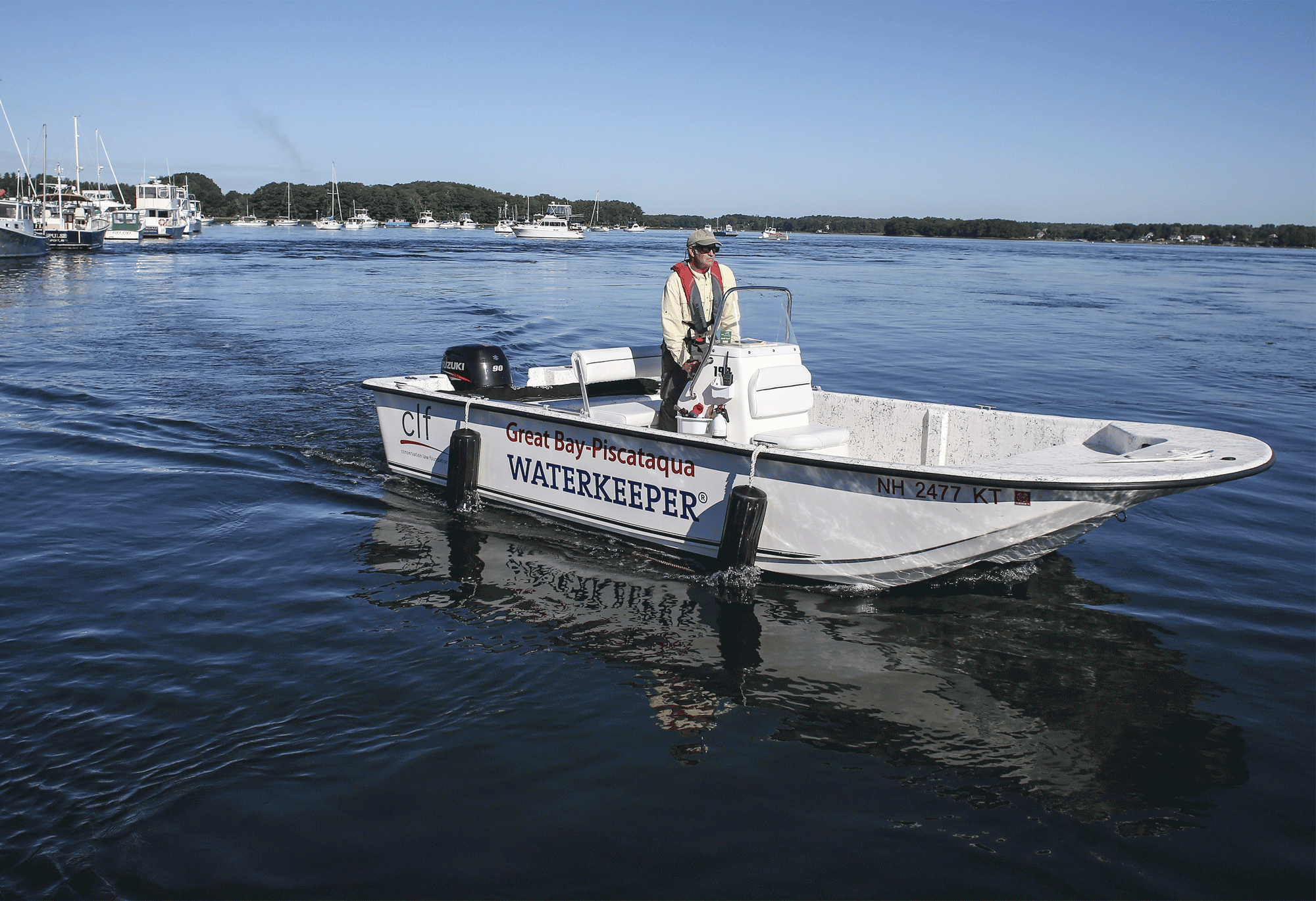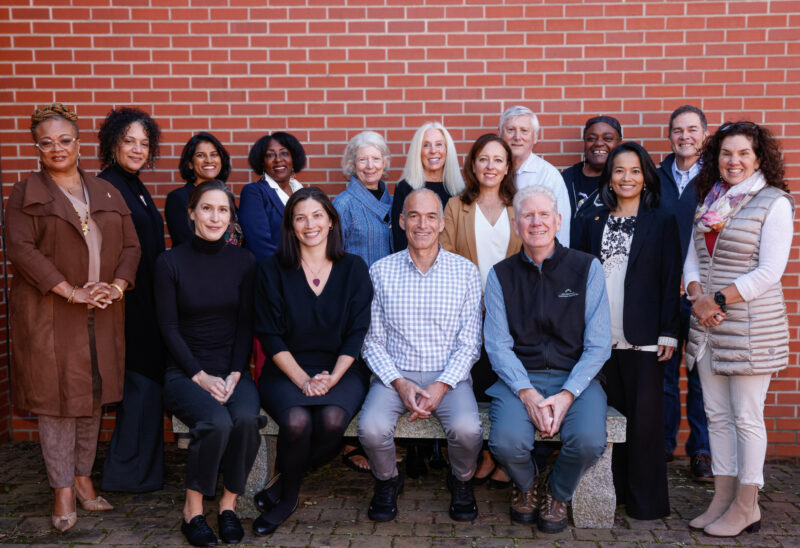It’s a sunny day in midsummer as Jeff Barnum maneuvers a shallow-draft bay boat from its slip at Great Bay Marine in Newington. Tide was high at 5:47 a.m. and would be again at 6:13 p.m. Now, at just after 8 a.m., the day is all warm breeze and promise of fair weather. A cormorant touches wingtips to water and takes off. Common terns dive straight down to puncture the surface, like winged darts. White buoys come into view off the bow, demarking a new oyster farm.
Your eyes might take in what looks like a pristine estuary and tell you that everything is fine. But then your eyes would lie.
There is a crisis brewing beneath these waters.
“Unless it’s on fire, or there’s an oil slick on it, people think ‘it looks just fine to me,’” said Barnum, who is the Great Bay-Piscataqua Waterkeeper with the Conservation Law Foundation. Barnum’s job is to spread the word, on water and land, about the health of this estuary.
And the estuary is not fine. Great Bay, one of the most significant estuaries in the country, was declared officially “impaired” by the Environmental Protection Agency in 2009.
The 1100 acres of natural oyster beds that existed in 1993 have declined to just 50. The estuary’s early ‘90s population of 25 million adult oysters experienced a massive die-off: just 1.2 million remained by 2000. Eelgrass is vanishing at a similarly alarming rate – with 700 acres lost in 20 years.
“We’re seeing a decline in the underpinning of the health of the system,” said Rachel Rouillard, who directs the Piscataqua Region Estuaries Partnership.
Oysters and eelgrass are critical to the health of the estuary: one oyster can filter 20 gallons of water in a single day. Eelgrass anchors sediment on the floor of the bay, oxygenates water and provides critical habitat as a “nursery” for species from lobsters to Atlantic cod.
“An acre of oysters can filter and lock up a half-ton of nitrogen per year,” Barnum says, and eelgrass “is where everything lives.”
Estuaries are colossally complex and rich ecosystems – and much of all living matter in the planet’s oceans depends on them. Great Bay is often called “the nursery” for fisheries in the Gulf of Maine.
When vast swaths of New Hampshire farmland, forest and wetlands were giving way to development in the ‘80s and ‘90s, the impact to habitats on land was obvious, and a series of collective efforts preserved important natural landscapes across New Hampshire.
Now a similar coalition – of organizations and agencies that have been working to protect and restore Great Bay and its watershed for decades – has put forth a “collective impact” strategy to restore and protect the ecological health of Great Bay. Partners include the Great Bay National Estuarine Research Reserve, the Piscataqua Region Estuaries Partnership, The Nature Conservancy, the New Hampshire Department of Environmental Services, and the Conservation Law Foundation.
“We want to face this together, as a team,” Rouillard said.
The Great Bay 2020 “blueprint” lays out a shared vision of highest priority goals and strategies and describes how impact will be measured.
The new framework, said Rouillard, “is a potential game-changer for this region.”
Mark Zankel, executive director of the Nature Conservancy, spoke about Great Bay 2020 at the Foundation’s 2016 annual meeting.
The Foundation brought the group together, made grants to support the planning and creation of the blueprint and invited donors to the table who are passionate and committed to saving Great Bay.
“We saw an opportunity to be a catalyst,” said Kevin Peterson, senior program officer for the environment at New Hampshire Charitable Foundation. “Every organization involved was doing good work. We wanted to help them step back, see the issue through a wider lens and create a stronger, coordinated vision.”
“Great Bay 2020 is a strategic plan for how to move the needle,” Rouillard said. “Without the Charitable Foundation’s support, we wouldn’t be here.”
Generous New Hampshire citizens have long played a critical role in protecting and preserving the Great Bay estuary and watershed. And they came to the table to give input into the creation of Great Bay 2020.
“These exceptionally committed donors have been deeply and passionately engaged in this work for a long time – being patient and dedicated, and also pushing back,” Rouillard said. They “want to be really strategic, and that is a critical part of this equation.”
Philanthropy will be a key driver in the initiative’s success.
Jay McSharry, a member of the Foundation’s Piscataqua Regional Advisory Board, hosted an event at one of his Portsmouth restaurants for donors interested in the project.
“The energy in the room was really positive,” McSharry said. “The more knowledge and communication you have, the more you can work together to get the best results.”
Progress has already been made and momentum continues to build: 13 acres of oyster reefs have been restored and the population has edged back up to 2.2 million adult oysters. Six thousand acres of land in the watershed have been preserved, sewage treatment facilities have been upgraded and more are slated for upgrades.
Westy Lovejoy grew up on a farm on the Cocheco River in the Great Bay watershed, canoeing on the river, trapping muskrats whose pelts she sold to Sears & Roebuck for coat-making at 50 cents apiece. She has long supported conservation efforts around Great Bay, and served on the Foundation’s Piscataqua Region Advisory Board.
Mounting a coordinated effort, Lovejoy said, is “the only way it’s going to work. We’ve learned that with land trusts and everything else. You’ve got to collaborate. You’re all telling the same story, so why not do it together?”
The Foundation is supporting the efforts spelled out in Great Bay 2020. Recent grants of nearly $200,000 add to the more than $1.5 million since 2011 that generous donors have made it possible for the Charitable Foundation to invest in projects that support the protection of Great Bay — and more grants are planned in 2016. These efforts are complemented by a $250,000 loan to The Nature Conservancy’s Gulf of Maine Fisheries Restoration program from the Foundation’s new Impact Investment Fund.
The Great Bay watershed comprises 52 towns over about 1,000 square miles. One-third of the state’s population lives in that watershed.Tweet This
The blueprint is ambitious and the process won’t be simple. The Great Bay watershed comprises 52 towns over about 1,000 square miles. One-third of the state’s population lives in that watershed, where everything from lawn fertilizers to sewage treatment plants affects the ecosystem. Scientists are still working to fully understand the critical and fragile estuarine system and the multi-layered causes of its current distress.
“What is abundantly clear is that the time to act is now, before a tipping point is passed,” said Charitable Foundation president and CEO Richard Ober. “Great Bay has not reached the same level of distress as other estuaries – like Chesapeake Bay, for instance. And it is infinitely easier, and cheaper, to protect the health of an estuary than to resuscitate one after it collapses.”
Barnum turns the shallow-draft boat back toward the marina, scans the chop on the bay and says this, with certainty:
“It’s not too late.”



















